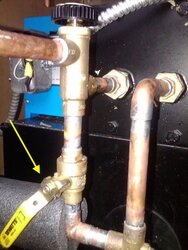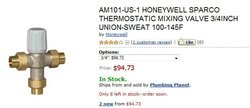Hello
My friend got a new boiler and because of extremely limited space it had to have a tankless coil for DHW. Due to code requirements a mixing valve must be put in on the tankless hot output.
So we put in a ball valve on the cold input to the mixing valve so when the spring scales up inside we can cut down the cold and still get some hot water.
We tried it out and shut off the cold and got some really nice hot water for the sink and shower!
I do want to mention that there are no children around that would run the faucets too hot. Also he can open the ball valve and go back it he wishes.
So I do not recommend this but those mixing valves do NOT work well and if used properly this might help get a little more hot water when really needed without calling the boiler emergency number!
Has anyone tried this?
My friend got a new boiler and because of extremely limited space it had to have a tankless coil for DHW. Due to code requirements a mixing valve must be put in on the tankless hot output.
So we put in a ball valve on the cold input to the mixing valve so when the spring scales up inside we can cut down the cold and still get some hot water.
We tried it out and shut off the cold and got some really nice hot water for the sink and shower!
I do want to mention that there are no children around that would run the faucets too hot. Also he can open the ball valve and go back it he wishes.
So I do not recommend this but those mixing valves do NOT work well and if used properly this might help get a little more hot water when really needed without calling the boiler emergency number!
Has anyone tried this?




